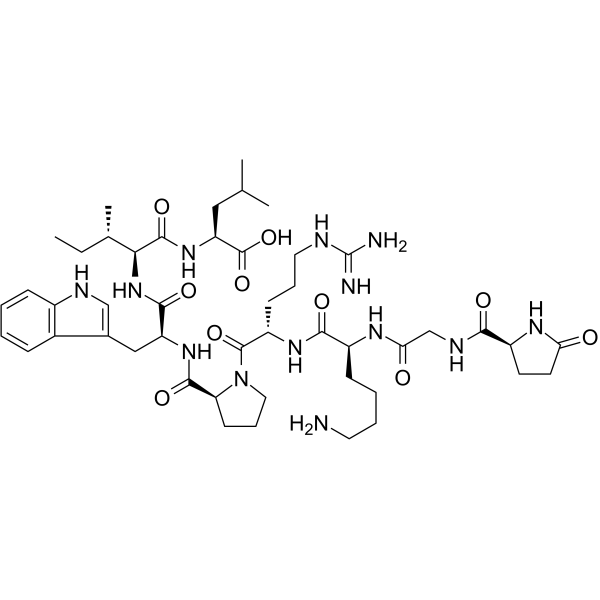Search Result
Results for "
Octapeptide
" in MedChemExpress (MCE) Product Catalog:
| Cat. No. |
Product Name |
Target |
Research Areas |
Chemical Structure |
-
- HY-P1896
-
|
|
HSP
|
Infection
Neurological Disease
Cancer
|
|
Hsp70-derived octapeptide is a conserved octapeptide of the C-terminal end of Hsp70, which physically interacts with tetratricopeptide repeat (TPR) motifs .
|
-
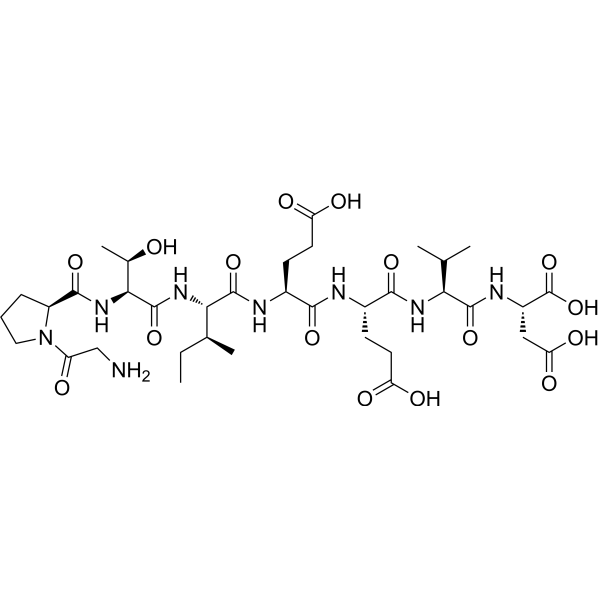
-
- HY-N9528
-
-

-
- HY-P0093
-
|
Cholecystokinin Octapeptide; CCK-8; SQ19844
|
Cholecystokinin Receptor
Apoptosis
PI3K
Akt
|
Infection
Cancer
|
|
Sincalide (Cholecystokinin octapeptide, CCK‐8) is a rapid-acting amino acid polypeptide hormone analogue of cholecystokinin (CCK) for intravenous use in postevacuation cholecystography. CCK‐8 is a major bioactive segment of CCK that retains most of the biological activities of CCK. CCK‐8 can promote gallbladder contraction by injection and helps diagnose gallbladder and pancreas disorders. CCK‐8 can increase bile secretion, cause the gallbladder to contract and relax the sphincter of Oddi, resulting in bile drainage into the duodenum. CCK‐8 is a major bioactive segment of CCK that retains most of the biological activities of CCK .
|
-

-
- HY-P0093A
-
|
Cholecystokinin Octapeptide ammonium; CCK-8 ammonium; SQ19844 ammonium
|
Cholecystokinin Receptor
Apoptosis
PI3K
Akt
|
Infection
Cancer
|
|
Sincalide ammonium (Cholecystokinin octapeptide ammonium, CCK-8 ammonium) is a rapid-acting amino acid polypeptide hormone analogue of cholecystokinin (CCK) for intravenous use in postevacuation cholecystography. Sincalide ammonium is a major bioactive segment of CCK that retains most of the biological activities of CCK. CCK‐8 can promote gallbladder contraction by injection and helps diagnose gallbladder and pancreas disorders. Sincalide ammonium can increase bile secretion, cause the gallbladder to contract and relax the sphincter of Oddi, resulting in bile drainage into the duodenum. Sincalide ammonium is a major bioactive segment of CCK that retains most of the biological activities of CCK .
|
-

-
- HY-P5253
-
-

-
- HY-103277A
-
|
|
Bombesin Receptor
|
Neurological Disease
Metabolic Disease
|
|
BIM 23042 TFA, a certain somatostatin (SS) octapeptide analogue, is a selective neuropeptide neuromedin B receptor (NMB-R, BB1) antagonist. BIM 23042 has 100-fold lower affinity for gastrin-releasing peptide (GRP) receptor (BB2). BIM 23042 inhibits Neuromedin B (HY-P0241), ICI 216140 and DPDM-bombesin ethylamide-induced Ca 2+ release .
|
-
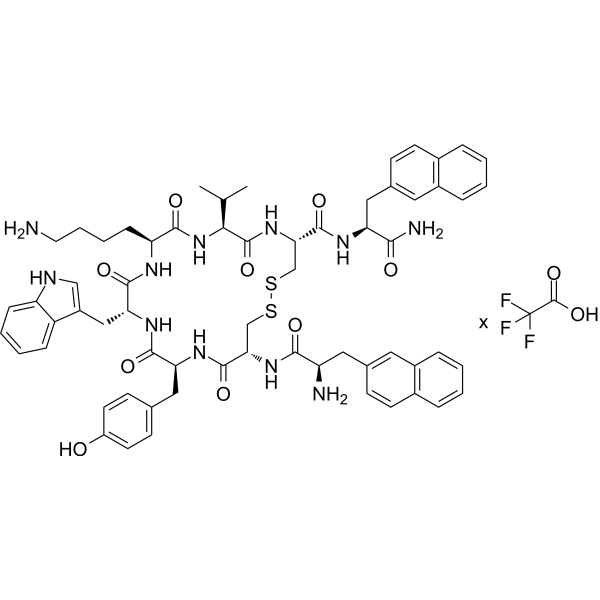
-
- HY-P3800
-
|
|
Neurokinin Receptor
|
Neurological Disease
Endocrinology
|
|
[Glp5] Substance P (5-11) is an octapeptide. [Glp5] Substance P (5-11) is one of the main substance P fragments in rat central nervous system (CNS). [Glp5] Substance P (5-11) locally modulates dopamine release in rat striatum .
|
-
![[Glp5] Substance P (5-11)](//file.medchemexpress.com/product_pic/hy-p3800.gif)
-
- HY-P2090
-
|
|
Somatostatin Receptor
Adenylate Cyclase
|
Cardiovascular Disease
|
|
Angiopeptin, a cyclic octapeptide analogue of somatostatin, is a weak sst2/sst5 receptor partial agonist with IC50 values of 0.26 nM and 6.92 nM, respectively. Angiopeptin is a potent inhibitor of growth hormone release and insulin-like growth factor-1 (IGF-1) production. Angiopeptin inhibits adenylate cyclase or stimulates extracellular acidification. Angiopeptin has the potential for coronary atherosclerosis research .
|
-
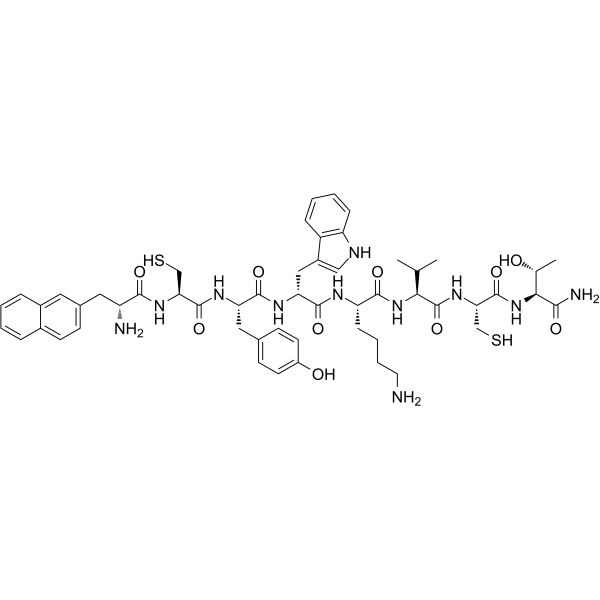
-
- HY-P2090A
-
|
|
Somatostatin Receptor
Adenylate Cyclase
|
Cardiovascular Disease
|
|
Angiopeptin TFA, a cyclic octapeptide analogue of somatostatin, is a weak sst2/sst5 receptor partial agonist with IC50 values of 0.26 nM and 6.92 nM, respectively. Angiopeptin TFA is a potent inhibitor of growth hormone release and insulin-like growth factor-1 (IGF-1) production. Angiopeptin TFA inhibits adenylate cyclase or stimulates extracellular acidification. Angiopeptin TFA has the potential for coronary atherosclerosis research .
|
-
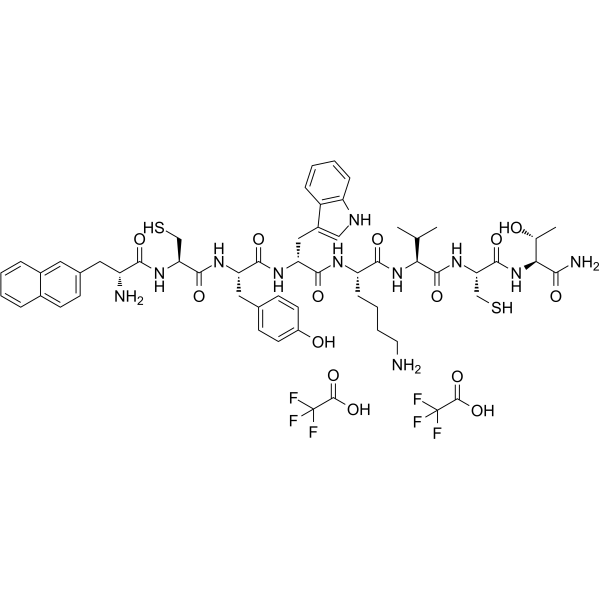
-
- HY-103277
-
|
|
Bombesin Receptor
|
Neurological Disease
Metabolic Disease
|
|
BIM 23042, a certain somatostatin (SS) octapeptide analogue, is a selective neuropeptide neuromedin B receptor (NMB-R, BB1) antagonist. BIM 23042 has 100-fold lower affinity for gastrin-releasing peptide (GRP) receptor (BB2). BIM 23042 inhibits Neuromedin B (HY-P0241), ICI 216140 and DPDM-bombesin ethylamide-induced Ca 2+ release .
|
-
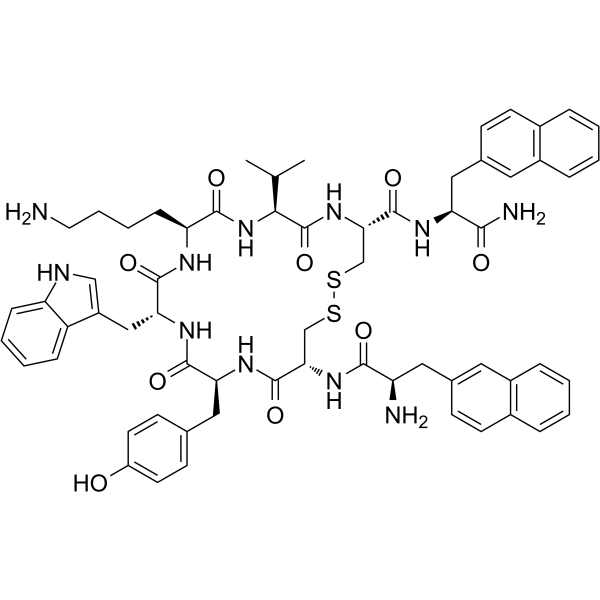
-
- HY-P1087
-
|
Metorphamide
|
Opioid Receptor
|
Cancer
|
|
Adrenorphin is a opioid octapeptide, acting as a potent agonist of μ-opioid receptor, with Ki of 12 nM.
|
-
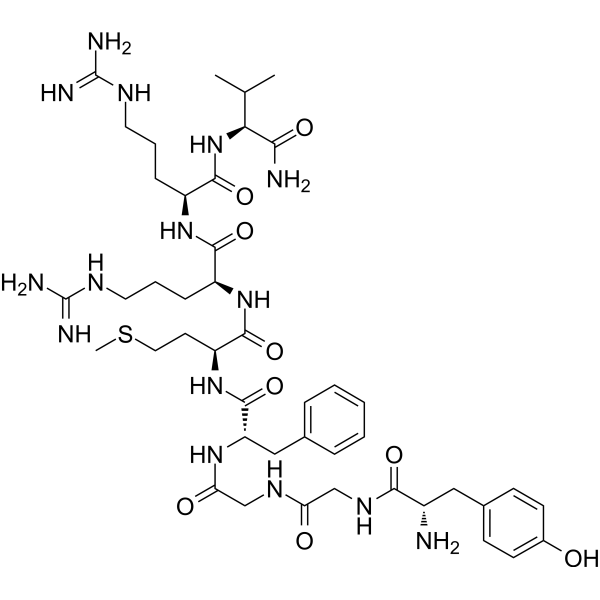
-
- HY-N12840
-
|
|
Others
|
Metabolic Disease
|
|
Logmalicid B is an iridoid glycoside compound that can be isolated from Cornus officinalis and can be used in diabetes research .
|
-

-
- HY-P1505
-
|
Complement 3a (70-77)
|
Complement System
|
Inflammation/Immunology
|
|
C3a (70-77) is an octapeptide corresponding to the COOH terminus of C3a, exhibits the specificity and 1 to 2% biologic activities of C3a.
|
-
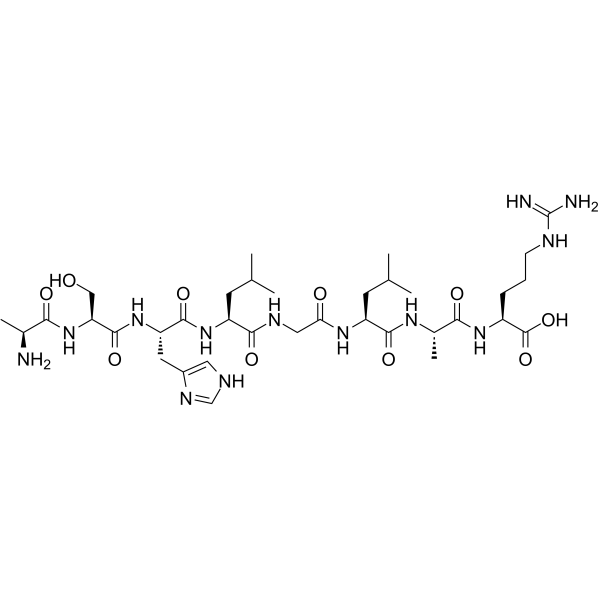
-
- HY-P1203
-
-
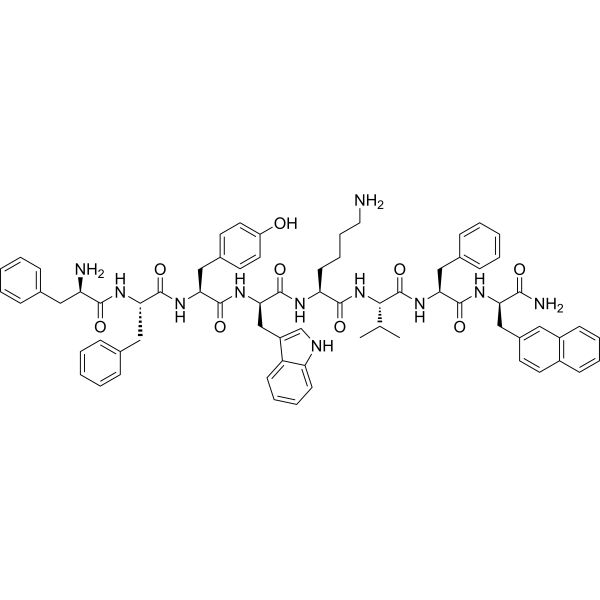
-
- HY-P1203A
-
-
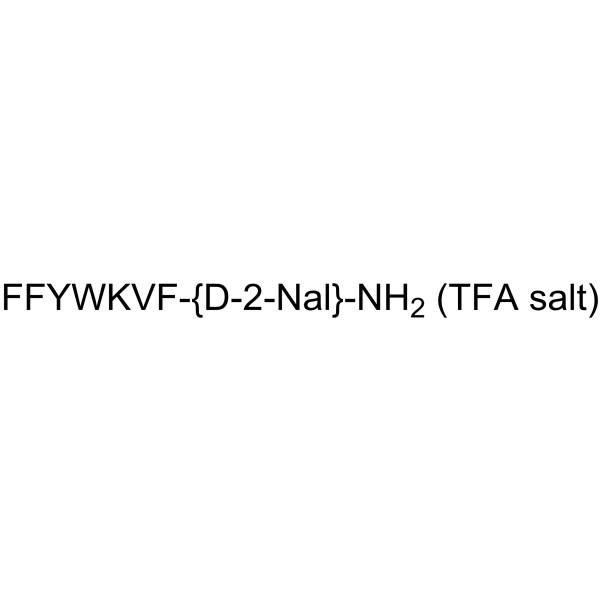
-
- HY-128878
-
|
|
Cholecystokinin Receptor
|
Metabolic Disease
Endocrinology
|
|
Dexloxiglumide is a selective cholecystokinin type A (CCKA) receptor antagonist . Dexloxiglumide, the active enantiomer of Loxiglumide, inhibits smooth muscle cell contractions induced by cholecystokinin-octapeptide (CCK-8) .
|
-
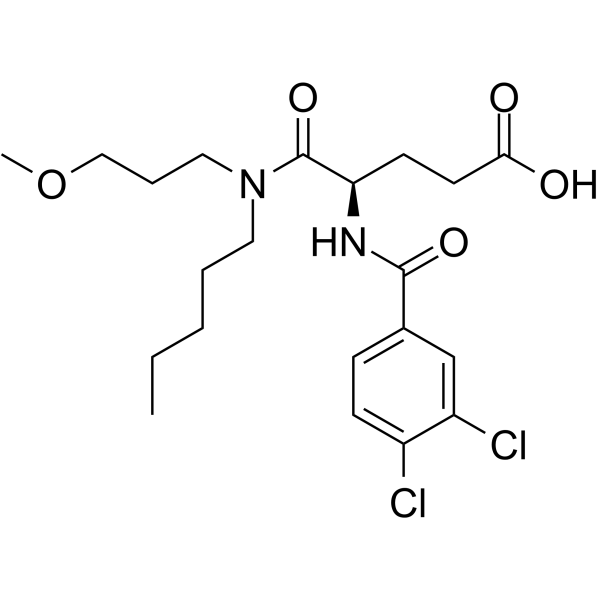
-
- HY-P0272
-
|
|
HIV
|
Infection
|
|
Peptide T is an octapeptide from the V2 region of HIV-1 gp120. Peptide T is a ligand for the CD4 receptor and prevents binding of HIV to the CD4 receptor.
|
-
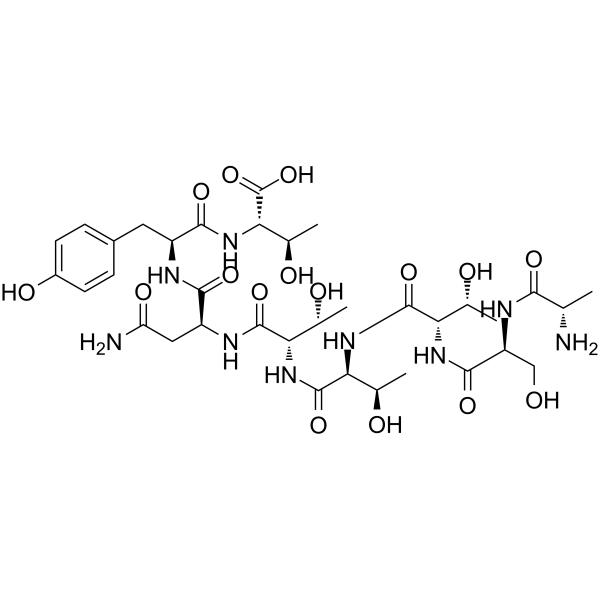
-
- HY-P0272A
-
|
|
HIV
|
Infection
|
|
Peptide T (TFA) is an octapeptide from the V2 region of HIV-1 gp120. Peptide T is a ligand for the CD4 receptor and prevents binding of HIV to the CD4 receptor.
|
-
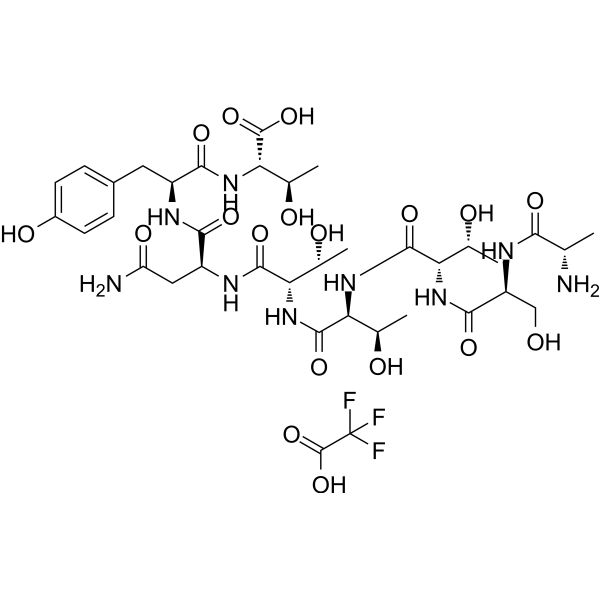
-
- HY-P1505A
-
|
Complement 3a (70-77) (TFA)
|
Complement System
|
Inflammation/Immunology
|
|
C3a (70-77) TFA (Complement 3a (70-77) TFA) is an octapeptide corresponding to the COOH terminus of C3a, exhibits the specificity and 1 to 2% biologic activities of C3a .
|
-

-
- HY-P4574
-
|
|
MMP
|
Others
|
|
VPLSLYSG is an octapeptide that can be degraded by matrix metalloproteinase-9 (MMP-9), MMP-1 and MMP-2. VPLSLYSG has potential applications in MMP substrates .
|
-
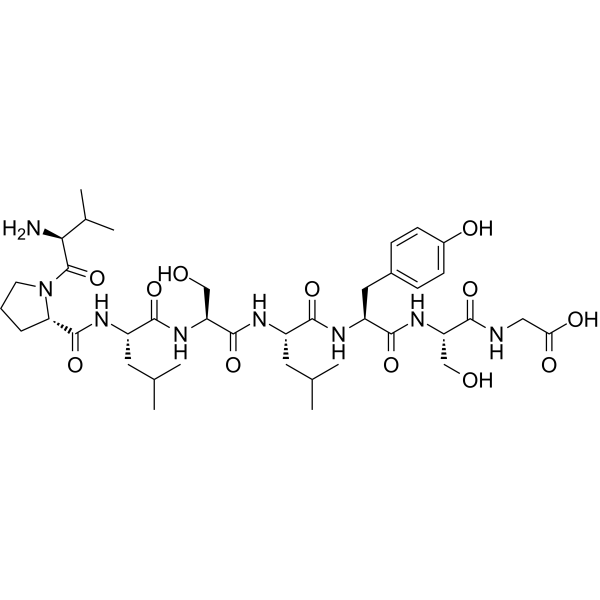
-
- HY-125301
-
|
|
Others
|
Inflammation/Immunology
|
|
Thymoctonan (THF-γ2) is the immunomodulatory octapeptide, thymic humoral factor γ2. Thymoctonan has the half-life less than 6 min at 37 °C in blood from human, rat and mouse .
|
-
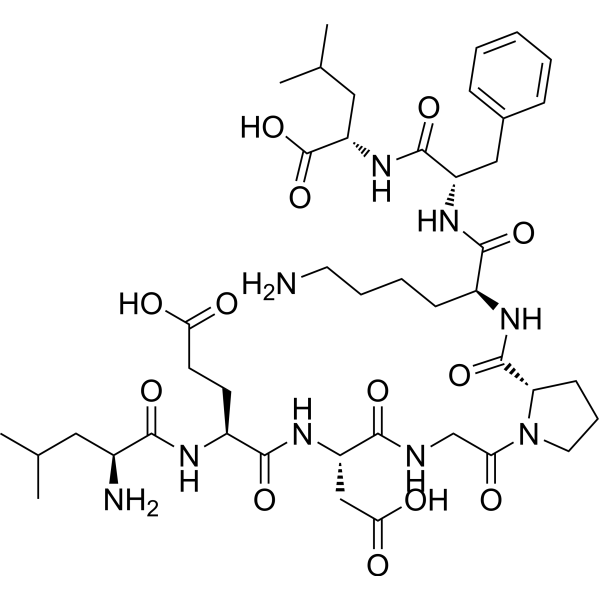
-
- HY-N11970
-
|
|
Angiotensin-converting Enzyme (ACE)
|
Metabolic Disease
|
|
Isocrenatoside (compound 6) is a cyclic octapeptide and an inhibitor of angiotensin-converting enzyme (ACE). Isocrenatoside is isolated from the ethanolic extract of Microtoena prainiana stems. Studies have found that the inhibitory efficiency of 1 mg/mL Isocrenatoside can reach 99.3% .
|
-

-
- HY-P1248
-
|
NPFF
|
Neuropeptide FF Receptor
|
Cardiovascular Disease
|
|
Neuropeptide FF (NPFF), an octapeptide belonging to the RF-amide family of peptides, interacts with two distinct G-protein-coupled receptors, NPFF(1) and NPFF(2) and has wide variety of physiological functions in the brain including central cardiovascular and neuroendocrine regulation .
|
-
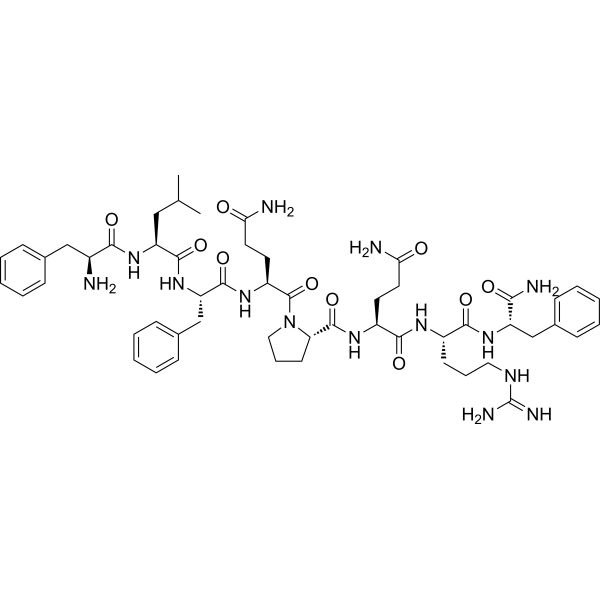
-
- HY-P4764
-
|
|
Melanocortin Receptor
|
Cardiovascular Disease
|
|
Ac-DArg-c[Cys-Glu-His-DPhe-Arg-Trp-Cys]-NH 2 is a cyclic octapeptide with MC4R agonism. Ac-DArg-c[Cys-Glu-His-DPhe-Arg-Trp-Cys]-NH 2 significantly increases heart rate and blood pressure .
|
-
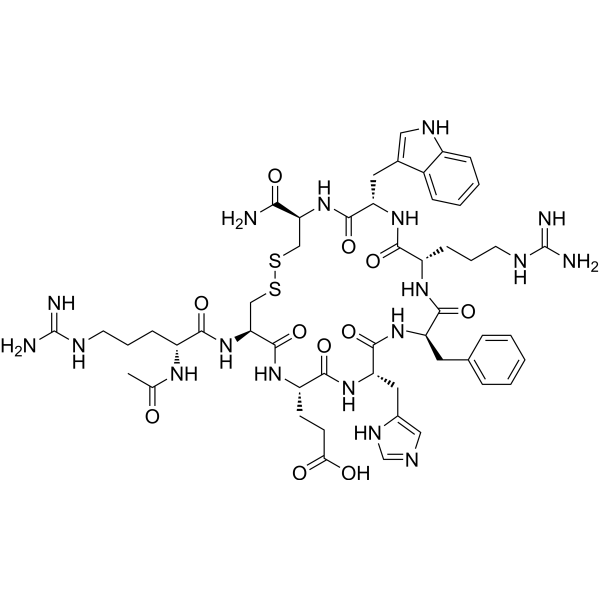
-
- HY-P1202
-
|
|
Somatostatin Receptor
|
Endocrinology
|
|
CYN 154806, a cyclic octapeptide, is a potent and selective somatostatin sst2 receptor antagonist, with pIC50 values of 8.58, 5.41, 6.07, 5.76 and 6.48 for human recombinant sst2, sst1, sst3, sst4 and sst5 receptors respectively .
|
-

-
- HY-P1202A
-
|
|
Somatostatin Receptor
|
Endocrinology
|
|
CYN 154806 TFA, a cyclic octapeptide, is a potent and selective somatostatin sst2 receptor antagonist, with pIC50 values of 8.58, 5.41, 6.07, 5.76 and 6.48 for human recombinant sst2, sst1, sst3, sst4 and sst5 receptors respectively .
|
-
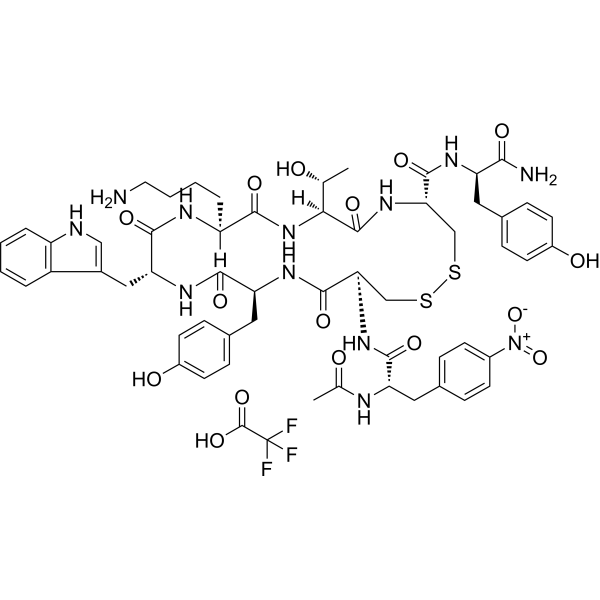
-
- HY-P0205A
-
|
[Sar1,Ala8] Angiotensin II acetate hydrate
|
Angiotensin Receptor
|
Cardiovascular Disease
Inflammation/Immunology
|
|
Saralasin ([Sar1,Ala8] Angiotensin II) acetate hydrate is an octapeptide analog of angiotensin II. Saralasin acetate hydrate is a competitive angiotensin II receptor antagonist with a Ki value of 0.32 nM for 74% of the binding sites, and has partial agonist activity as well. Saralasin acetate hydrate can be used for the research of renovascular hypertension, renin-dependent (angiotensinogenic) hypertension .
|
-
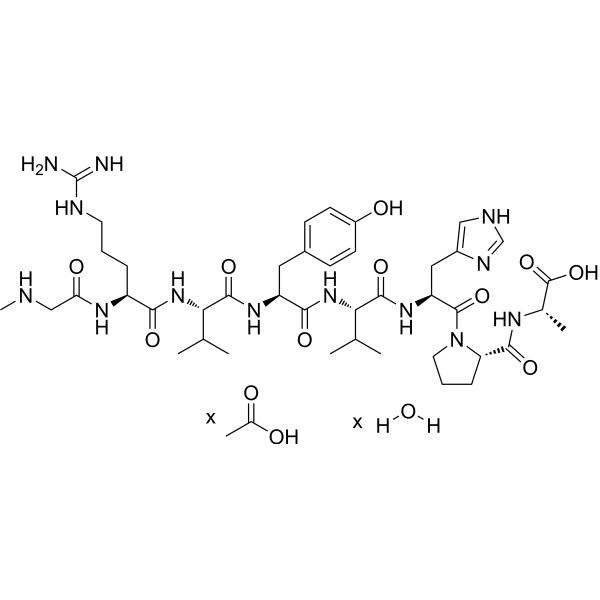
-
- HY-P0205
-
|
[Sar1,Ala8] Angiotensin II
|
Angiotensin Receptor
|
Cardiovascular Disease
Inflammation/Immunology
|
|
Saralasin ([Sar1,Ala8] Angiotensin II) is an octapeptide analog of angiotensin II. Saralasin is a competitive angiotensin II receptor antagonist with a Ki value of 0.32 nM for 74% of the binding sites, and has partial agonist activity as well. Saralasin can be used for the research of renovascular hypertension, renin-dependent (angiotensinogenic) hypertension .
|
-
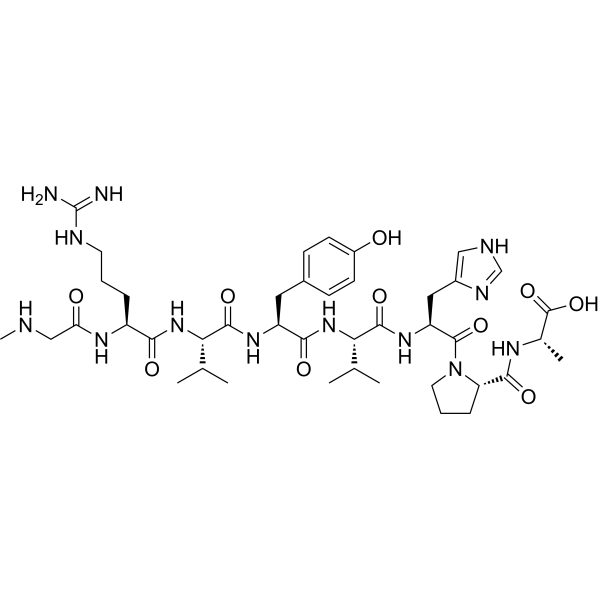
-
- HY-P0205B
-
|
[Sar1,Ala8] Angiotensin II TFA
|
Angiotensin Receptor
|
Cardiovascular Disease
Inflammation/Immunology
|
|
Saralasin ([Sar1,Ala8] Angiotensin II) TFA is an octapeptide analog of angiotensin II. Saralasin TFA is a competitive angiotensin II receptor antagonist with a Ki value of 0.32 nM for 74% of the binding sites, and has partial agonist activity as well. Saralasin TFA can be used for the research of renovascular hypertension, renin-dependent (angiotensinogenic) hypertension .
|
-

-
- HY-P0036
-
Octreotide
Maximum Cited Publications
10 Publications Verification
SMS 201-995
|
Somatostatin Receptor
Apoptosis
|
Cardiovascular Disease
Inflammation/Immunology
Endocrinology
Cancer
|
|
Octreotide (SMS 201-995) is a somatostatin receptor agonist and synthetic octapeptide endogenous somatostatin analogue. Octreotide (SMS 201-995) can bind to the somatostatin receptor and mainly subtypes 2, 3, and 5, increases Gi activity, and reduces intracellular cAMP production. Octreotide (SMS 201-995) has antitumor activity, mediates apoptosis and may also be used in disease studies in acromegaly .
|
-
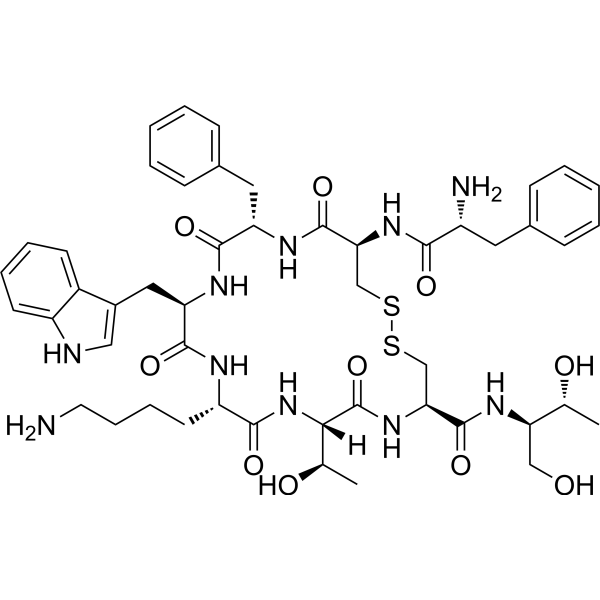
-
- HY-P0036B
-
|
SMS 201-995 pamoate
|
Somatostatin Receptor
Apoptosis
|
Cardiovascular Disease
Inflammation/Immunology
Endocrinology
Cancer
|
|
Octreotide (SMS 201-995) pamoate is a somatostatin receptor agonist and synthetic octapeptide endogenous somatostatin analogue. Octreotide pamoate can bind to the somatostatin receptors which are mainly subtypes 2, 3 and 5. Octreotide pamoate increases Gi activity and reduces intracellular cAMP production. Octreotide pamoate has antitumor activity, mediates apoptosis and may also be used in disease studies in acromegaly .
|
-
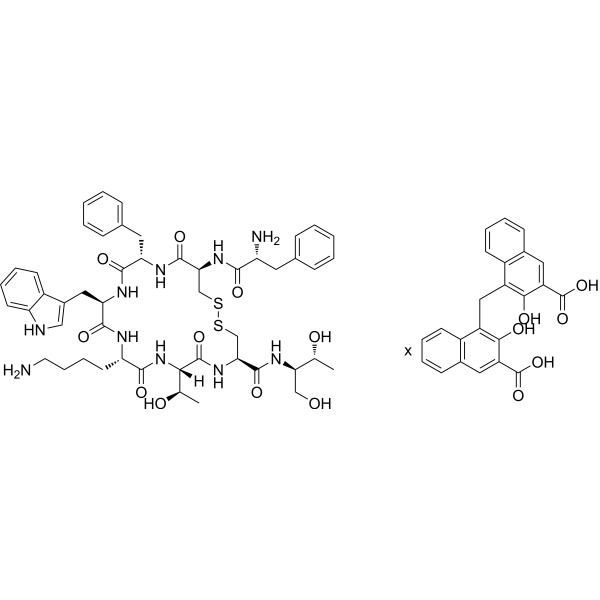
-
- HY-P2434
-
|
|
Somatostatin Receptor
|
Neurological Disease
Metabolic Disease
Cancer
|
|
AP102 is a dual SSTR2/SSTR5-specific somatostatin analog (SSA). AP102 is a disulfide-bridged octapeptide SSA containing synthetic iodinated amino acids. AP102 binds with subnanomolar affinity to SSTR2 and SSTR5 (IC50: 0.63 and 0.65 nM, respectively). AP102 does not bind to SSTR1 or SSTR3. AP102 can be used for acromegaly and neuroendocrine tumors research .
|
-
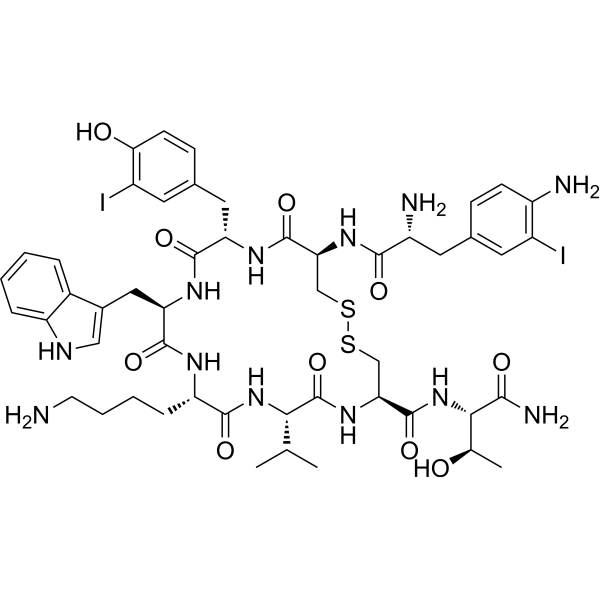
-
- HY-151829
-
|
|
ADC Linker
|
Others
|
|
Fmoc-L-Asn(EDA-N3)-OH is a click chemistry reagent containing an azide group. This building block is reported in literature for the modification of Amanitin via Click Chemistry. Alpha-Amanitin is the deadliest member of the amatoxin peptide family produced by the death-cap mushroom A. phalloides. It is an orally available, rigid, bicyclic octapeptide and one of the most lethal known natural products (LD50 = 50-100 μg/kg) acting as highly selective allosteric inhibitor of the RNA polymerase II .
|
-
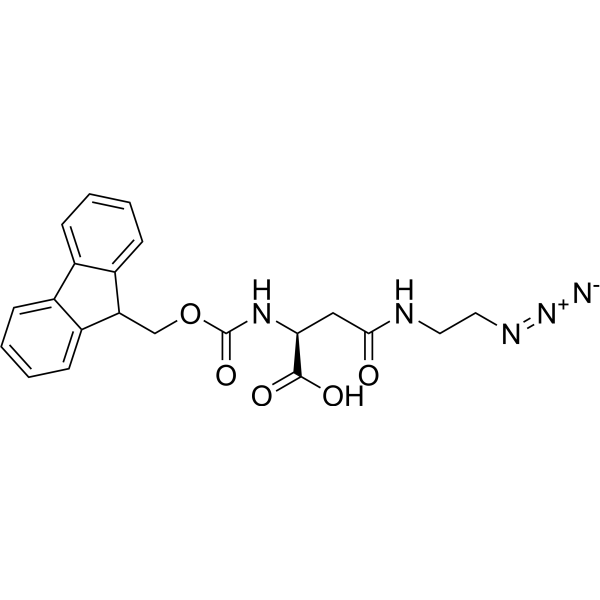
| Cat. No. |
Product Name |
Target |
Research Area |
-
- HY-P0196
-
|
CCK Octapeptide, desulfated
|
Peptides
|
Metabolic Disease
|
|
Cholecystokinin Octapeptide, desulfated is a synthetic desulfated octapeptides of cholecystokinin (CCK) .
|
-
- HY-P0196A
-
|
CCK Octapeptide, desulfated TFA
|
Peptides
|
Metabolic Disease
|
|
Cholecystokinin Octapeptide, desulfated TFA is a synthetic desulfated octapeptides of Cholecystokinin (CCK) .
|
-
- HY-P1896
-
|
|
HSP
|
Infection
Neurological Disease
Cancer
|
|
Hsp70-derived octapeptide is a conserved octapeptide of the C-terminal end of Hsp70, which physically interacts with tetratricopeptide repeat (TPR) motifs .
|
-
- HY-P5253
-
-
- HY-P0065
-
|
|
Peptides
|
Others
|
|
Acetyl octapeptide-1 is a bioactive peptide with anti-wrinkle effect and has been reported used as a cosmetic ingredient .
|
-
- HY-P0253
-
|
|
Peptides
|
Metabolic Disease
|
|
Xenopsin, a neurotensin-like octapeptide from Xenopus laevis skin . Xenopsin is an inhibitor of Tetragastrin stimulated gastric acid secretion .
|
-
- HY-P0253A
-
|
|
Peptides
|
Metabolic Disease
|
|
Xenopsin TFA, a neurotensin-like octapeptide from Xenopus laevis skin . Xenopsin TFA is an inhibitor of Tetragastrin stimulated gastric acid secretion .
|
-
- HY-P5000
-
|
H-Asp-Tyr-OH
|
Peptides
|
Others
|
|
Cholecystokinin Octapeptide (1-2) (desulfated) (H-Asp-Tyr-OH) is a polypeptide that can be found by peptide screening. Peptide screening is a research tool that pools active peptides primarily by immunoassay. Peptide screening can be used for protein interaction, functional analysis, epitope screening, especially in the field of agent research and development .
|
-
- HY-P0093
-
|
Cholecystokinin Octapeptide; CCK-8; SQ19844
|
Cholecystokinin Receptor
Apoptosis
PI3K
Akt
|
Infection
Cancer
|
|
Sincalide (Cholecystokinin octapeptide, CCK‐8) is a rapid-acting amino acid polypeptide hormone analogue of cholecystokinin (CCK) for intravenous use in postevacuation cholecystography. CCK‐8 is a major bioactive segment of CCK that retains most of the biological activities of CCK. CCK‐8 can promote gallbladder contraction by injection and helps diagnose gallbladder and pancreas disorders. CCK‐8 can increase bile secretion, cause the gallbladder to contract and relax the sphincter of Oddi, resulting in bile drainage into the duodenum. CCK‐8 is a major bioactive segment of CCK that retains most of the biological activities of CCK .
|
-
- HY-P2081
-
|
|
Peptides
|
Others
|
|
Delicious peptide is a small linear octapeptide with delicious taste, can be isolated from the gravy of beef meat. Delicious peptide has savory flavor, is also described as beefy meaty peptide and a beef flavor enhancer .
|
-
- HY-P0093A
-
|
Cholecystokinin Octapeptide ammonium; CCK-8 ammonium; SQ19844 ammonium
|
Cholecystokinin Receptor
Apoptosis
PI3K
Akt
|
Infection
Cancer
|
|
Sincalide ammonium (Cholecystokinin octapeptide ammonium, CCK-8 ammonium) is a rapid-acting amino acid polypeptide hormone analogue of cholecystokinin (CCK) for intravenous use in postevacuation cholecystography. Sincalide ammonium is a major bioactive segment of CCK that retains most of the biological activities of CCK. CCK‐8 can promote gallbladder contraction by injection and helps diagnose gallbladder and pancreas disorders. Sincalide ammonium can increase bile secretion, cause the gallbladder to contract and relax the sphincter of Oddi, resulting in bile drainage into the duodenum. Sincalide ammonium is a major bioactive segment of CCK that retains most of the biological activities of CCK .
|
-
- HY-103277A
-
|
|
Bombesin Receptor
|
Neurological Disease
Metabolic Disease
|
|
BIM 23042 TFA, a certain somatostatin (SS) octapeptide analogue, is a selective neuropeptide neuromedin B receptor (NMB-R, BB1) antagonist. BIM 23042 has 100-fold lower affinity for gastrin-releasing peptide (GRP) receptor (BB2). BIM 23042 inhibits Neuromedin B (HY-P0241), ICI 216140 and DPDM-bombesin ethylamide-induced Ca 2+ release .
|
-
- HY-P3800
-
|
|
Neurokinin Receptor
|
Neurological Disease
Endocrinology
|
|
[Glp5] Substance P (5-11) is an octapeptide. [Glp5] Substance P (5-11) is one of the main substance P fragments in rat central nervous system (CNS). [Glp5] Substance P (5-11) locally modulates dopamine release in rat striatum .
|
-
- HY-P1257
-
|
|
Peptides
|
Metabolic Disease
|
|
Xenin-8, a C-terminal octapeptide, is a biologically active fragment of Xenin. Xenin is a 25-amino acid peptide of the neurotensin/xenopsin family. Xenin-8 stimulates basal insulin secretion and potentiates the insulin response to glucose in a dose-dependent manner (EC50=0.16 nM) .
|
-
- HY-P1257A
-
|
|
Peptides
|
Metabolic Disease
|
|
Xenin-8 TFA, a C-terminal octapeptide, is a biologically active fragment of Xenin. Xenin is a 25-amino acid peptide of the neurotensin/xenopsin family. Xenin-8 TFA stimulates basal insulin secretion and potentiates the insulin response to glucose in a dose-dependent manner (EC50=0.16 nM) .
|
-
- HY-P2090
-
|
|
Somatostatin Receptor
Adenylate Cyclase
|
Cardiovascular Disease
|
|
Angiopeptin, a cyclic octapeptide analogue of somatostatin, is a weak sst2/sst5 receptor partial agonist with IC50 values of 0.26 nM and 6.92 nM, respectively. Angiopeptin is a potent inhibitor of growth hormone release and insulin-like growth factor-1 (IGF-1) production. Angiopeptin inhibits adenylate cyclase or stimulates extracellular acidification. Angiopeptin has the potential for coronary atherosclerosis research .
|
-
- HY-P2090A
-
|
|
Somatostatin Receptor
Adenylate Cyclase
|
Cardiovascular Disease
|
|
Angiopeptin TFA, a cyclic octapeptide analogue of somatostatin, is a weak sst2/sst5 receptor partial agonist with IC50 values of 0.26 nM and 6.92 nM, respectively. Angiopeptin TFA is a potent inhibitor of growth hormone release and insulin-like growth factor-1 (IGF-1) production. Angiopeptin TFA inhibits adenylate cyclase or stimulates extracellular acidification. Angiopeptin TFA has the potential for coronary atherosclerosis research .
|
-
- HY-103277
-
|
|
Bombesin Receptor
|
Neurological Disease
Metabolic Disease
|
|
BIM 23042, a certain somatostatin (SS) octapeptide analogue, is a selective neuropeptide neuromedin B receptor (NMB-R, BB1) antagonist. BIM 23042 has 100-fold lower affinity for gastrin-releasing peptide (GRP) receptor (BB2). BIM 23042 inhibits Neuromedin B (HY-P0241), ICI 216140 and DPDM-bombesin ethylamide-induced Ca 2+ release .
|
-
- HY-P1496
-
-
- HY-P1087
-
|
Metorphamide
|
Opioid Receptor
|
Cancer
|
|
Adrenorphin is a opioid octapeptide, acting as a potent agonist of μ-opioid receptor, with Ki of 12 nM.
|
-
- HY-P1760
-
|
|
Peptides
|
Neurological Disease
|
|
Allatostatin IV is an octapeptide. Allatostatins are pleiotropic neuropeptides for inhibition of juvenile hormone synthesis in insects .
|
-
- HY-P4909
-
|
|
Peptides
|
Infection
|
|
Autoinducing Peptide I is a cyclic octapeptide secreted by Staphylococcus aureus and can be used in vaccine research .
|
-
- HY-P1505
-
|
Complement 3a (70-77)
|
Complement System
|
Inflammation/Immunology
|
|
C3a (70-77) is an octapeptide corresponding to the COOH terminus of C3a, exhibits the specificity and 1 to 2% biologic activities of C3a.
|
-
- HY-P1203
-
-
- HY-P1203A
-
-
- HY-P4957
-
|
|
Peptides
|
Others
|
|
Octreotide dimer parallel is a dimer parallel of Octreotide. Octreotide (HY-P0036) is a somatostatin receptor agonist and synthetic octapeptide endogenous somatostatin analogue .
|
-
- HY-P4705
-
|
|
Peptides
|
Inflammation/Immunology
|
|
Hymenistatin I is a cyclic octapeptide [c-(-Pro-Pro-Tyr-Val-Pro-Leu-Ile-ile-Ile-)] with immunosuppressive activity in both humoral and cellular immune responses .
|
-
- HY-P0272
-
|
|
HIV
|
Infection
|
|
Peptide T is an octapeptide from the V2 region of HIV-1 gp120. Peptide T is a ligand for the CD4 receptor and prevents binding of HIV to the CD4 receptor.
|
-
- HY-P0272A
-
|
|
HIV
|
Infection
|
|
Peptide T (TFA) is an octapeptide from the V2 region of HIV-1 gp120. Peptide T is a ligand for the CD4 receptor and prevents binding of HIV to the CD4 receptor.
|
-
- HY-P1505A
-
|
Complement 3a (70-77) (TFA)
|
Complement System
|
Inflammation/Immunology
|
|
C3a (70-77) TFA (Complement 3a (70-77) TFA) is an octapeptide corresponding to the COOH terminus of C3a, exhibits the specificity and 1 to 2% biologic activities of C3a .
|
-
- HY-P4574
-
|
|
MMP
|
Others
|
|
VPLSLYSG is an octapeptide that can be degraded by matrix metalloproteinase-9 (MMP-9), MMP-1 and MMP-2. VPLSLYSG has potential applications in MMP substrates .
|
-
- HY-P4796
-
|
Proglucagon (33-69)
|
Peptides
|
Metabolic Disease
|
|
Oxyntomodulin (human, mouse, rat) (Proglucagon (33-69)) is a product of the glucagon precursor. Oxyntomodulin (human, mouse, rat) contains the entire glucagon sequence plus a C-terminal octapeptide, comprising in total 37 amino acids.
|
-
- HY-P1248
-
|
NPFF
|
Neuropeptide FF Receptor
|
Cardiovascular Disease
|
|
Neuropeptide FF (NPFF), an octapeptide belonging to the RF-amide family of peptides, interacts with two distinct G-protein-coupled receptors, NPFF(1) and NPFF(2) and has wide variety of physiological functions in the brain including central cardiovascular and neuroendocrine regulation .
|
-
- HY-P4764
-
|
|
Melanocortin Receptor
|
Cardiovascular Disease
|
|
Ac-DArg-c[Cys-Glu-His-DPhe-Arg-Trp-Cys]-NH 2 is a cyclic octapeptide with MC4R agonism. Ac-DArg-c[Cys-Glu-His-DPhe-Arg-Trp-Cys]-NH 2 significantly increases heart rate and blood pressure .
|
-
- HY-P1202
-
|
|
Somatostatin Receptor
|
Endocrinology
|
|
CYN 154806, a cyclic octapeptide, is a potent and selective somatostatin sst2 receptor antagonist, with pIC50 values of 8.58, 5.41, 6.07, 5.76 and 6.48 for human recombinant sst2, sst1, sst3, sst4 and sst5 receptors respectively .
|
-
- HY-P1202A
-
|
|
Somatostatin Receptor
|
Endocrinology
|
|
CYN 154806 TFA, a cyclic octapeptide, is a potent and selective somatostatin sst2 receptor antagonist, with pIC50 values of 8.58, 5.41, 6.07, 5.76 and 6.48 for human recombinant sst2, sst1, sst3, sst4 and sst5 receptors respectively .
|
-
- HY-P2019
-
|
|
Peptides
|
Neurological Disease
|
|
Levitide is a neurohormone-like peptide, can be isolated from skin secretions of the South African frog Xenopus laevis. Levitide comes from preprolevitide, is 88 residues long and contains contains the levitide peptide at the C terminus (Glu-Gly-Met-Ile-Gly-Thr-Leu-Thr-Ser-Lys-Arg-Ile-Lys-Gln-NH2) and the putative signal sequence at the N terminus .
|
-
- HY-P0205A
-
|
[Sar1,Ala8] Angiotensin II acetate hydrate
|
Angiotensin Receptor
|
Cardiovascular Disease
Inflammation/Immunology
|
|
Saralasin ([Sar1,Ala8] Angiotensin II) acetate hydrate is an octapeptide analog of angiotensin II. Saralasin acetate hydrate is a competitive angiotensin II receptor antagonist with a Ki value of 0.32 nM for 74% of the binding sites, and has partial agonist activity as well. Saralasin acetate hydrate can be used for the research of renovascular hypertension, renin-dependent (angiotensinogenic) hypertension .
|
-
- HY-P0205
-
|
[Sar1,Ala8] Angiotensin II
|
Angiotensin Receptor
|
Cardiovascular Disease
Inflammation/Immunology
|
|
Saralasin ([Sar1,Ala8] Angiotensin II) is an octapeptide analog of angiotensin II. Saralasin is a competitive angiotensin II receptor antagonist with a Ki value of 0.32 nM for 74% of the binding sites, and has partial agonist activity as well. Saralasin can be used for the research of renovascular hypertension, renin-dependent (angiotensinogenic) hypertension .
|
-
- HY-P0205B
-
|
[Sar1,Ala8] Angiotensin II TFA
|
Angiotensin Receptor
|
Cardiovascular Disease
Inflammation/Immunology
|
|
Saralasin ([Sar1,Ala8] Angiotensin II) TFA is an octapeptide analog of angiotensin II. Saralasin TFA is a competitive angiotensin II receptor antagonist with a Ki value of 0.32 nM for 74% of the binding sites, and has partial agonist activity as well. Saralasin TFA can be used for the research of renovascular hypertension, renin-dependent (angiotensinogenic) hypertension .
|
-
- HY-P0036
-
Octreotide
Maximum Cited Publications
10 Publications Verification
SMS 201-995
|
Somatostatin Receptor
Apoptosis
|
Cardiovascular Disease
Inflammation/Immunology
Endocrinology
Cancer
|
|
Octreotide (SMS 201-995) is a somatostatin receptor agonist and synthetic octapeptide endogenous somatostatin analogue. Octreotide (SMS 201-995) can bind to the somatostatin receptor and mainly subtypes 2, 3, and 5, increases Gi activity, and reduces intracellular cAMP production. Octreotide (SMS 201-995) has antitumor activity, mediates apoptosis and may also be used in disease studies in acromegaly .
|
-
- HY-P0036B
-
|
SMS 201-995 pamoate
|
Somatostatin Receptor
Apoptosis
|
Cardiovascular Disease
Inflammation/Immunology
Endocrinology
Cancer
|
|
Octreotide (SMS 201-995) pamoate is a somatostatin receptor agonist and synthetic octapeptide endogenous somatostatin analogue. Octreotide pamoate can bind to the somatostatin receptors which are mainly subtypes 2, 3 and 5. Octreotide pamoate increases Gi activity and reduces intracellular cAMP production. Octreotide pamoate has antitumor activity, mediates apoptosis and may also be used in disease studies in acromegaly .
|
-
- HY-P2434
-
|
|
Somatostatin Receptor
|
Neurological Disease
Metabolic Disease
Cancer
|
|
AP102 is a dual SSTR2/SSTR5-specific somatostatin analog (SSA). AP102 is a disulfide-bridged octapeptide SSA containing synthetic iodinated amino acids. AP102 binds with subnanomolar affinity to SSTR2 and SSTR5 (IC50: 0.63 and 0.65 nM, respectively). AP102 does not bind to SSTR1 or SSTR3. AP102 can be used for acromegaly and neuroendocrine tumors research .
|
| Cat. No. |
Product Name |
Category |
Target |
Chemical Structure |
| Cat. No. |
Product Name |
|
Classification |
-
- HY-151829
-
|
|
|
Azide
|
|
Fmoc-L-Asn(EDA-N3)-OH is a click chemistry reagent containing an azide group. This building block is reported in literature for the modification of Amanitin via Click Chemistry. Alpha-Amanitin is the deadliest member of the amatoxin peptide family produced by the death-cap mushroom A. phalloides. It is an orally available, rigid, bicyclic octapeptide and one of the most lethal known natural products (LD50 = 50-100 μg/kg) acting as highly selective allosteric inhibitor of the RNA polymerase II .
|
Your information is safe with us. * Required Fields.
Inquiry Information
- Product Name:
- Cat. No.:
- Quantity:
- MCE Japan Authorized Agent:












![[Glp5] Substance P (5-11)](http://file.medchemexpress.com/product_pic/hy-p3800.gif)


























